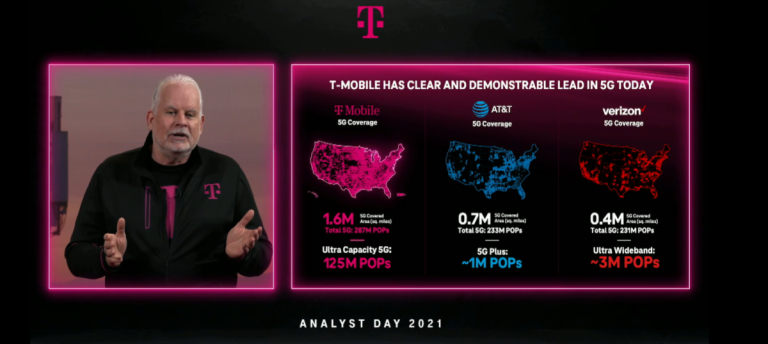T-Mobile marked two coverage milestones today, saying it has now covered 150 million people with its mid-band 5G and 300 million with its low-band network.
“300 million people covered is a huge milestone for us,” says Neville Ray, the company’s president of technology. “While our competition still seems to struggle with what they’re going to do with their 5G footprints, even with DSS, we continue on our march.”
To celebrate the event, the company is announcing its own-branded gin and ginger beer, which it’s selling at t-mobile5gin.com starting tomorrow at 3 p.m. ET. A bottle of gin costs $30 and a six-pack of ginger beer costs $10. I am not sure what happens if you consume “T-Mobile 5Ginger Beer” at the “Verizon UWBeach,” but I’m willing to find out.
I got the gin before I got the news, and I wrote a review of it here.
I’m in the middle of preparing for our annual Fastest Mobile Networks tests, where we drive-test 30 US cities and six rural regions. This year, things are wildly up for grabs. T-Mobile has extended its 5G network; Verizon has wired up beach towns; and AT&T keeps winning awards for its almost entirely 4G network. It’s going to be very, very interesting.
Maximizing Megahertz

T-Mobile’s landmark isn’t just about population covered, also known as pops. It’s about megahertz-pops, which measure the available bandwidth to each person. The value of 5G comes in offering wider channels than were available with 4G, and so T-Mobile is working hard to widen channels and thus increase speeds and capacity. Ray says the company aims to cover 200 million people with mid-band by the end of the year.
“The average across the footprint today is 60-80MHz,” Ray says. “The plan is to have that get to 100MHz as the ambition before the end of the year. With 200 million people covered by 100MHz of 2.5GHz spectrum, you get to 20 billion megahertz-pops of coverage,” he says.
Verizon will still be well behind T-Mobile next year, even when it turns on its upcoming C-band network, Ray asserted. Verizon aims to cover 100 million people with 60MHz of C-band next year. That’s 6 billion megahertz-pops to T-Mobile’s 20 billion.
“Even as Verizon and AT&T get their hands on the first tranche of C-band, it doesn’t change the game very much,” he says.
Of course, that doesn’t help people who have no T-Mobile coverage at all, as I found in the Finger Lakes of New York this April.
To expand coverage, T-Mobile is repurposing older Sprint sites and adding new “incremental” and “destination” sites to the network, Ray says. All of the new coverage is 5G.
“We have several thousand sites going into those incremental areas and we are spending a huge amount of time on how do we get better in those destination locations,” he says. “The gap between us and Verizon in most of those geographies is pretty small.”
Carrier aggregation between mid-band and low-band 5G will give T-Mobile a huge apparent coverage boost in 2022, Ray says. A phone needs both downlink and uplink to work, but uplink generally has shorter range than downlink. Replacing mid-band 4G uplink with low-band 5G uplink can extend mid-band 5G coverage by 30% and let T-Mobile transition to standalone 5G, which improves latency.
That’s a feature most frequently talked about with Qualcomm’s next-year X65 modems, but Ray says they’re working to “see if we can do that before X65.” That’s important because this year’s iPhone 13 line will probably feature Qualcomm’s X60 modem, which is also in the Galaxy S21 series.
What Is 5G For?

The company’s new home broadband offering is one way to use extra 5G capacity. I’ve been using T-Mobile’s home ISP service for the past two months; a full review is coming this week.
The company is still targeting 7-8 million home internet customers total, and it’s focused on rural and suburban areas. I’m using it in a city, but I’m a bit of a fluke (there’s a lot of excess mid-band capacity in my neighborhood.)
Beyond that, though, Ray says he’s looking at wearables as a possible major new 5G use.
“I do believe that wearables will be a story that starts in ’22,” he says. “The big FAANG guys, they’re all mobilizing a lot of investment and money in that. That might be the opening then, in terms of what happens with 5G devices and form factors. … We’re all waiting for that killer app. I don’t know what it will be, but it’s going to come.”

